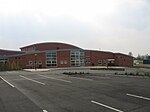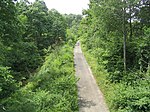Kinlet

Kinlet is a small village and civil parish in the south-east of the county of Shropshire, England. The parish is on the northern edge of the Wyre Forest and is in the Bridgnorth District of Shropshire. The parish incorporates the hamlets of Kinlet Village, Button Bridge and Button Oak. Kinlet is located 18 miles (29 km) south of Telford, the main town in Shropshire and 23 miles (37 km) west of Birmingham. The village is located in the centre of the parish. Its parish has a population of 680 according to the 2001 census, The land within the parish totals 8,164 acres (3,304 ha; 12.756 sq mi). increasing to 901 at the 2011 census. There is little in terms of employment in the parish, with residents travelling to nearby towns and cities.
Excerpt from the Wikipedia article Kinlet (License: CC BY-SA 3.0, Authors, Images).Kinlet
B4194,
Geographical coordinates (GPS) Address Nearby Places Show on map
Geographical coordinates (GPS)
| Latitude | Longitude |
|---|---|
| N 52.416 ° | E -2.416 ° |
Address
B4194
DY12 3AR
England, United Kingdom
Open on Google Maps









